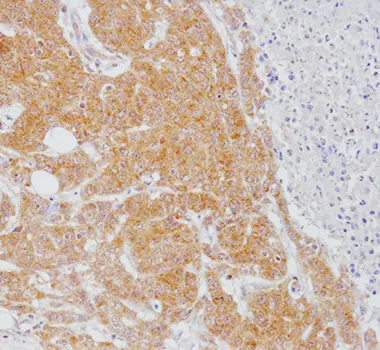L-Kynurenine Antibody – Rabbit Polyclonal
Ref: IS1012
Kynurenine pathwayTryptophan metabolismPolyclonal AntibodiesICCIFIHC
 +
+L-Kynurenine accumulation in human colorectal tumor by IHC
Immunohistochemical analysis reveals cytoplasmic accumulation of L-Kynurenine in tumour cells in human colorectal cancer tissue. Paraffin-embedded tissue section was subjected to pH=6 antigen retrieval, and overnight incubation with primary anti-KYN polyclonal antibody (1/500 dilution). A polymer-conjugated secondary Ab was added and immunostaining was revealed using DAB.
DatasheetMSDS
Validated for IHC in human tumor tissues, this anti-L-Kynurenine (Kyn) rabbit polyclonal antibody proved to work at 1/500 dilution on paraffin-embedded sections, a single vial thus catering for approximately 100 stainings.
| Clonality | Polyclonal |
| Host | Rabbit |
| Validated applications | IHC |
| Reactivity | Reacts with all species |
| References | Not yet cited to our knowledge. Submit content and get a 10% discount! |
| Format | 50µl |
| References | Cited in 2 papers |
| Size | 50µL |
|---|
449.00€
87 in stock
Worldwide shipping
Product overview
| Product name | L-Kynurenine polyclonal antibody |
| Synonyms | KYN polyclonal antibody
(S)-Kynurenine polyclonal antibody L-2-Amino-4-(2-aminophenyl)-4-oxobutanoic acid antibody Kynurenine polyclonal antibody 3-Anthraniloyl-L-alanine polyclonal antibody |
| Immunogen | Conjugated L-Kynurenine |
| Specificity | When tested in competitive ELISA, the anti-L-Kynurenine polyclonal antibody did not show any significant cross reactivity with competitors including anthranilic acid, 3-OH-Kynurenine conjugate and Tryptophan |
Storage
| Form | Liquid |
| Purity | Purified anti-serum |
| Storage | Store at +4°C for short term (1-2 months). Aliquot and store at -20°C for long term. Avoid repeated freeze / thaw cycles |
| Material safety datasheet | Download MSDS |
| Immunohistochemistry (IHC) | Dilute at 1:100-1:1000. Perform heat antigen retrieval (pH=6) before initiating IHC staining protocol on paraffin-embedded and frozen sections |
| Comments | Optimal working dilutions must be determined by the end-user |
| Restrictions | For research use only |
Product citations
- Indoleamine 2,3-dioxygenase (IDO)-1 and IDO-2 activity and severe course of COVID-19
Check the article
Authors : Guo et al., Journal of Pathology
2022-01 - In vivo inhibition of tryptophan catabolism reorganizes the tuberculoma and augments immune-mediated control of Mycobacterium tuberculosis
Check the article
Authors : Gautam et al., Proceedings of the National Academy of Sciences of the USA
2018-01




